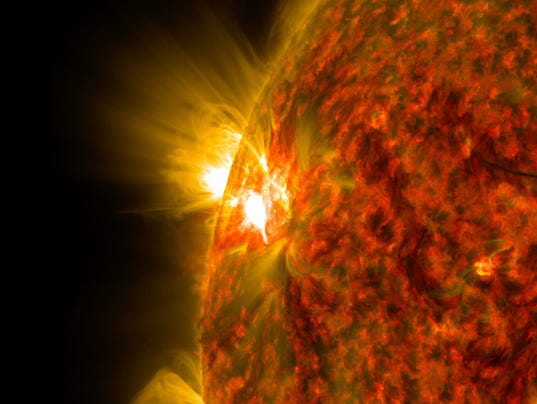See A Stunning Solar Flare Captured by NASA

A handout photo provided by the National Aeronautics and Space Administration (NASA) of a mid-level flare in November. A similar flare occurred December 16.
NASA’s Solar Dynamics Observatory, which continuously watches the sun, captured an image of a solar flare Tuesday. This one was considered “mid-level” and peaked around 11:50 p.m., according to NASA.
Solar flares are powerful surges of radiation that occur when magnetic energy connected to sunspots is released. Solar flares and sunspots are not unusual and occur with varying frequency depending on the solar cycle. “Space weather is always changing,” according to the Space Weather Prediction Center at NOAA.
Radiation from solar flares cannot hurt humans on the ground, but strong flares can interrupt the “atmosphere in the layer where GPS and communications signals travel,” according to NASA.
 The sun emitted a mid-level solar flare, peaking at 11:50 p.m. EST on Dec. 16, 2014. NASA’s Solar Dynamics Observatory, which watches the sun constantly, captured an image of the event. Solar flares are powerful bursts of radiation. Harmful radiation from a flare cannot pass through Earth’s atmosphere to physically affect humans on the ground, however — when intense enough — they can disturb the atmosphere in the layer where GPS and communications signals travel. This flare is classified as an M8.7-class flare. M-class flares are a tenth the size of the most intense flares, the X-class flares. The number provides more information about its strength. An M2 is twice as intense as an M1, an M3 is three times as intense, etc.
The sun emitted a mid-level solar flare, peaking at 11:50 p.m. EST on Dec. 16, 2014. NASA’s Solar Dynamics Observatory, which watches the sun constantly, captured an image of the event. Solar flares are powerful bursts of radiation. Harmful radiation from a flare cannot pass through Earth’s atmosphere to physically affect humans on the ground, however — when intense enough — they can disturb the atmosphere in the layer where GPS and communications signals travel. This flare is classified as an M8.7-class flare. M-class flares are a tenth the size of the most intense flares, the X-class flares. The number provides more information about its strength. An M2 is twice as intense as an M1, an M3 is three times as intense, etc.

[one_fourth]

The sun emitted a mid-level solar flare, peaking at 11:50 p.m. EST on Dec. 16, 2014.
NASA’s Solar Dynamics Observatory, which watches the sun constantly, captured an image of the event. Solar flares are powerful bursts of radiation. Harmful radiation from a flare cannot pass through Earth’s atmosphere to physically affect humans on the ground, however — when intense enough — they can disturb the atmosphere in the layer where GPS and communications signals travel. This flare is classified as an M8.7-class flare. M-class flares are a tenth the size of the most intense flares, the X-class flares. The number provides more information about its strength. An M2 is twice as intense as an M1, an M3 is three times as intense, etc.






